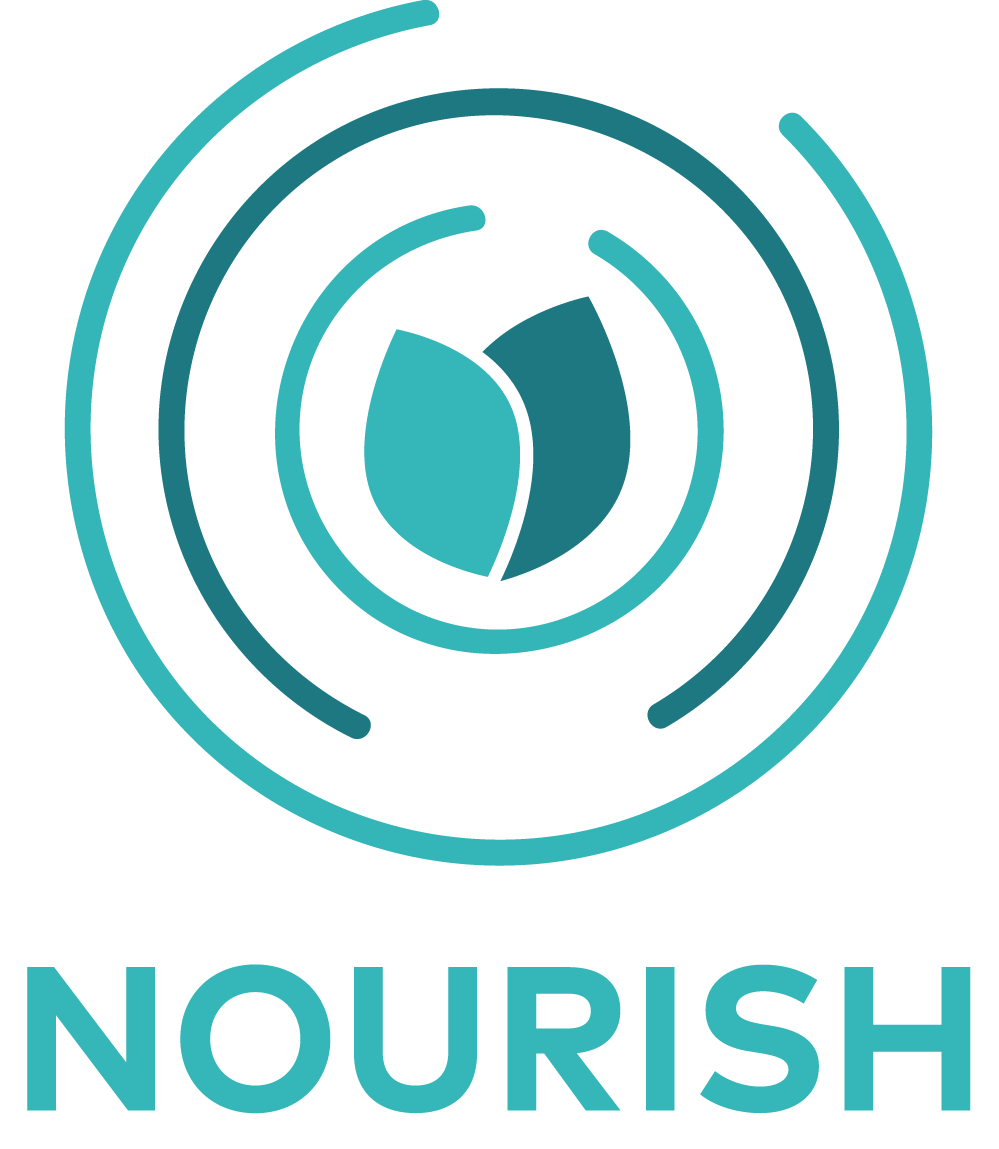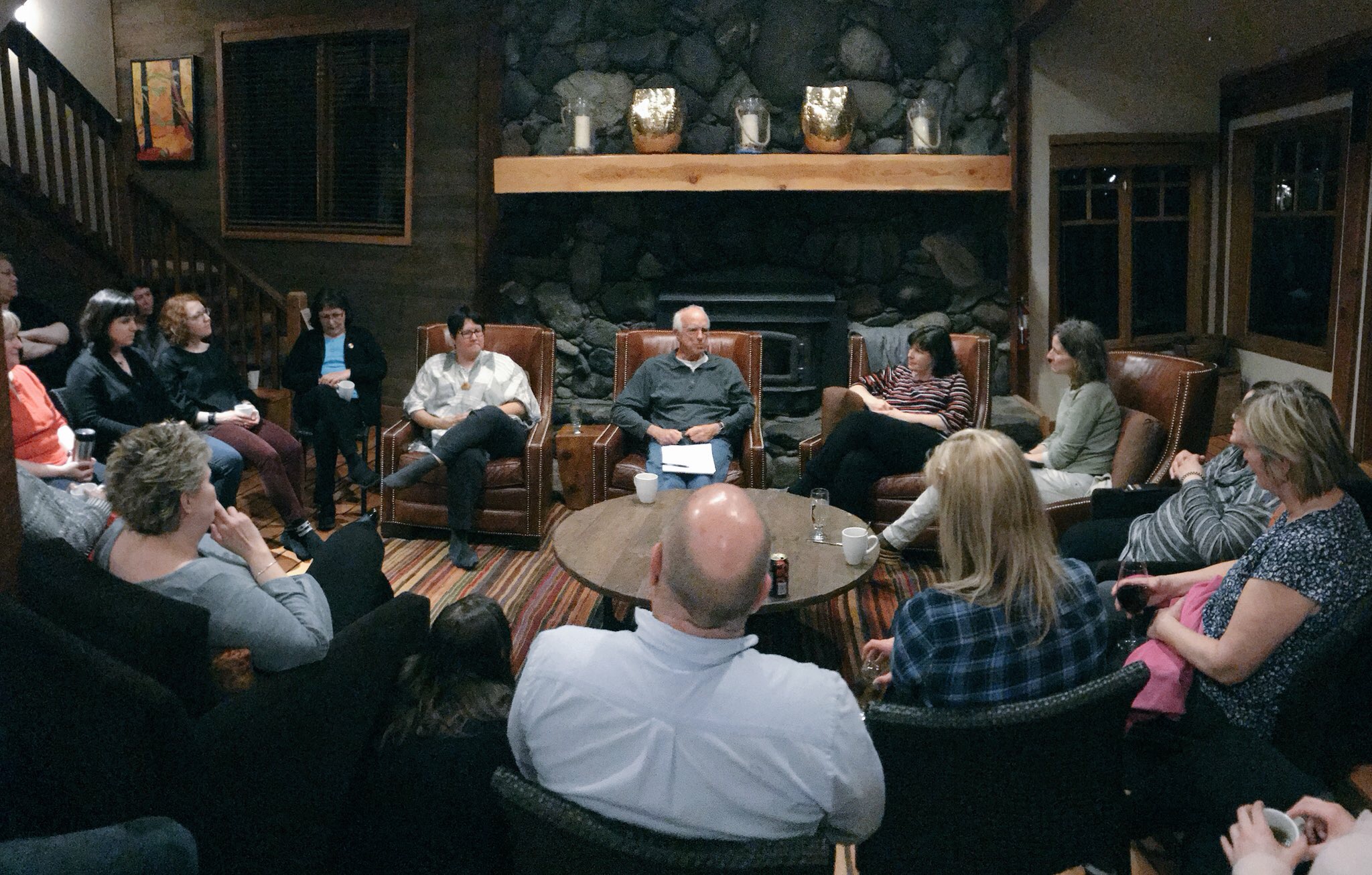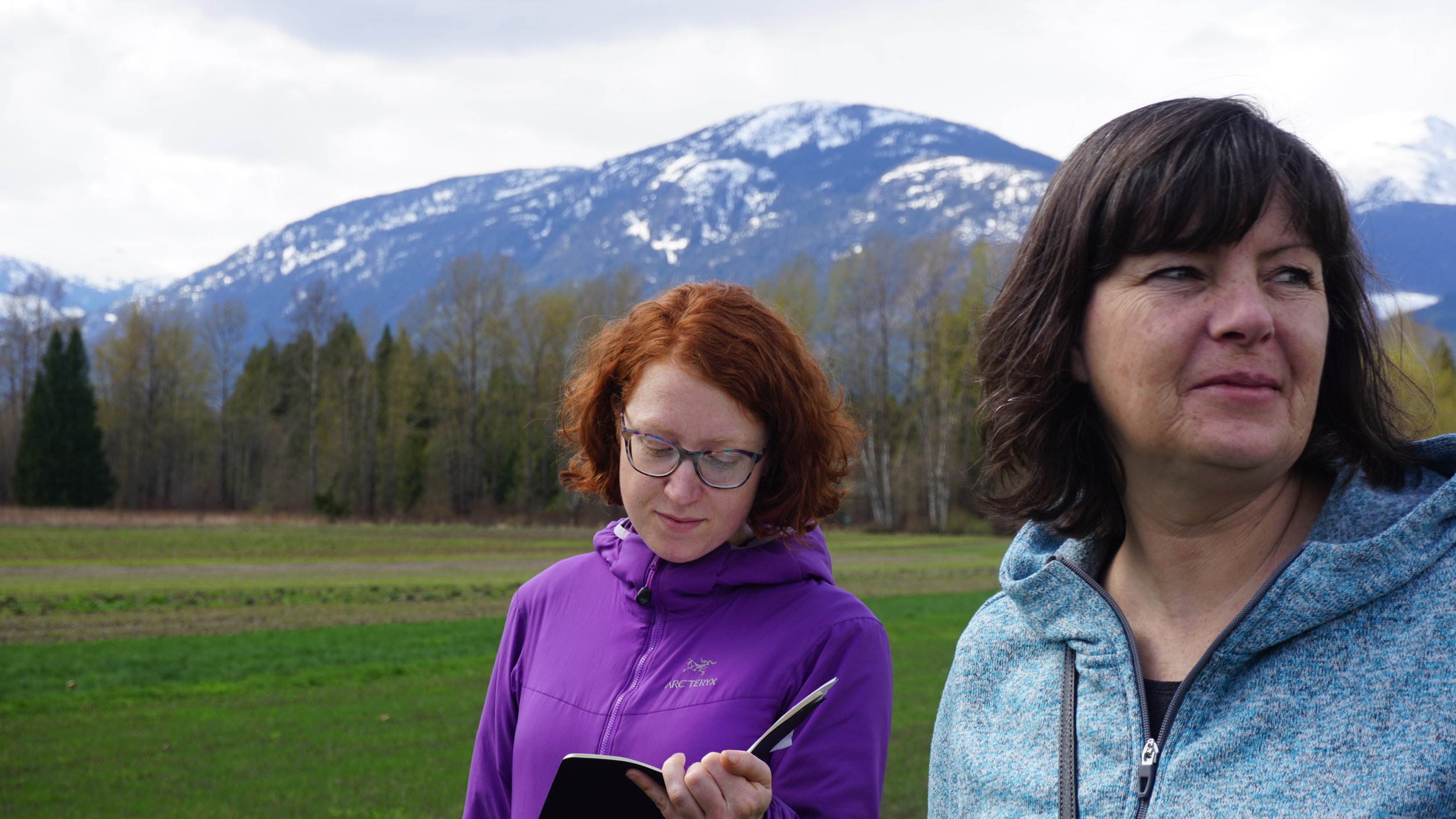Nourish innovators, advisors and team come together to meet in West Coast Salish territory in British Columbia
““We walk through life thinking we are wearing a headlamp on our heads, lighting up the world ahead of us. More often, we are wearing a projector on our heads, and seeing what we project into the world.” -”
The second Nourish cohort retreat took place in the middle of the mountains and woods on Coast Salish territory. After a long year of zoom and phone calls, the energy was high from having all 25 cohort members be physically back together for 5 days. The event was facilitated with simultaneous translation to help cross-fertilize learning across the English and French speaking cohort members.
The retreat started with a cultural journey through the Sea to Sky highway from Vancouver to Whistler, travelling through the unceded territory of the Coast Salish peoples, including the territories of the xwməθkwəy̓əm (Musqueam), Skwxwú7mesh (Squamish), Stó:lō and Səl̓ílwətaʔ/ Tsleil-Waututh (Slay-wa-tooth) Nations. During the drive, the innovators learned about legends including the giant two-headed serpent Sinulhka that left a cleft in the cliff-face known as Stawamus Chief, and Thunderbird, a giant bird that causes thunder and lightning and sits on peak of Black Tusk Mountain in Whistler as his favorite perch.
Gathering together for the opening circle to kick off the Nourish retreat.
““Indigenous food systems are the original sustainable food systems.””
Arriving at Brew Creek Centre, the retreat started with an opening circle where cohort members shared what they want to give and get to the group, as well as their key learnings of the year. One of the themes that emerged was a focus around Indigenous reconciliation; for example, Saskatchewan innovator Stephanie Cook’s decision to dedicate a part of her hospital garden to the medicine wheel, where she will link with elders to gain knowledge about growing traditional plants. Marianne Katusin from Halton Health in Ontario communicated a shift in her leadership model with increased engagement of her team in the local food journey. Josée Lavoie from CHU de St-Justine shared her success in championing room service and local food in her organization as well as the challenges of affecting change at a higher level. Many innovators shared their personal journeys including growing out of their comfort zones and into new leadership roles, and both successes and failures they faced trying to shift systems that can be complex and difficult to change.
The collaborative project teams were given the opportunity to ask for help, tapping into the wisdom and perspectives of their fellow cohort members through the Wise Crowds liberating structure. Project leads asked a powerful question they are grappling with in their projects, and took the time to listen to the group response:
Annie from the Sustainable Menus group asked: How might a sustainable menus tool be organized to be the most user friendly and meet your needs in menu creation?
Carlota’s team, working on the national patient experience measurement tool, asked: How would you approach testing the survey and what tools/supplies/resources would enable your participation?
Dan, whose group is creating a national RFP model, asked: How do you meaningfully capture your values in the criteria within a national RFP model, including values around Indigenous food ways?
Anne, leading a multi--stakeholder project on sustainable food procurement in Quebec, asked: What criteria around sustainable food procurement would be the most relevant to work on and develop together on a national level?
Marianne’s team, working toward the creation of meaningful targets and measures for institutional food procurement in the Local Food Act asked: What targets or measures for local food would be meaningful in your organization? What is a reasonable time frame for you to develop a baseline for reporting?
Kelly’s team, which is developing a resource for traditional food programming, asked: Imagine if you were using a resource/tool for a traditional program in your organization? What does it look like? What would you need to make it useful?
Asking these questions allowed the groups to validate and challenge their assumptions about their projects.
An evening ‘fireside chat’ was held to hear from Nourish Advisors: Melanie Goodchild, Hal Hamilton and Wendy Smith
On the second day of the retreat, the group took learning journeys to experience varied perspectives of what’s happening “in the field” of sustainable agriculture and deepen understanding of Indigenous history and culture. The cohort members visited two or more of the following places:
Nourish innovator Tessie Harris and Nourish advisor Wendy Smith visit North Arm organic farm.
Bill from the Squamish-Lil’Wat Cultural Centre shares his personal experiences living on the land with the group.
North Arm, a 55-acre certified organic farm in Pemberton that is one of the larger farms in the region and family-managed by Tracy & Jordan.
Squamish-Lil’Wat Cultural Centre, a centre dedicated to the joint history and culture of the Squamish and Lil’wat First Nations. A tour was led by Bill, a senior First Nations member of the community.
Artisan Farm, small-scale permaculture and biodynamic farm located in Paradise Valley run and owned by Emily. First Nations educator Senaquwila joined the tour for an ethnobotany walk to share teachings about local medicinal plants.
Helmer’s, an organic seed potato farm located in the beautiful Pemberton Valley. Anna and her family have been farming organically since clearing the land in 1980. They sent the group home with three bags of potatoes for the chef to use at dinner.
Shaw Creek Farm, a family-owned seed potato farm operated by John and Michelle, whose generational farming practice continues to evolve based on the belief that the customers' needs are of the utmost importance.
Green Bee, a small beekeeping operation run by Darwyn and Michalina, who grew up on the west coast, moved to Squamish for school, and started their own beekeeping farm as a backdrop to their full time gigs working with the Squamish Food Policy Council.
The learning journeys were an opportunity for the cohort members to reflect on their relationship to the land and the ways in which the health care sector can connect with the food and agricultural systems.
The sustainable menus team prototype together.
The next day, the cohort members went through a prototyping session, which allowed them to build and test their collaborative project ideas. Prototyping allowed them to use craft materials, storyboarding and performance to bring their ideas to life and share their work with the rest of the cohort. For example, the prototyping exercise enabled the traditional foods team to communicate and share their pivot from the development of a traditional foods guide and liberate themselves from the confines of the project budget and timeline. The patient experience group was able to craft their story of the transformative power of measuring food experience, and the RFP group workshopped the challenge of balancing clear purchasing criteria with the integration of cultural and spiritual change.
The traditional food ways team collectively prototype the journey of pivoting their project.
The Nourish retreat created the space and time for the Nourish cohort members to take a leap forward with their collaborative projects, and collectively reflect on their journeys and plan for the future. In the closing circle, there was a collective desire to communicate Nourish successes more broadly and bring challenges to the attention of policy makers, making lasting systemic change in the healthcare sector around food.
Turning their sights to the path forward, cohort members wrote bold and inspiring future headlines. Here are just a few:
Nourish creates a legacy; 25 food service leaders create exemplary food experiences for patients!
The Truth and Reconciliation Commission (TRC) has influenced how we all strengthen our connection with food, its role in culture and how this promotes well-being.
How you heard the buzz? Healthcare honey production is here to stay.
New sustainable menus reflect the needs of patients, buy-in from stakeholders and the value of traditional food.
Patients overjoyed with the food experience in Canada!
25 Innovators across Canada changed food in health care. Now it’s your turn!
Retreat Attendees
Nourish Innovators
Andrea Connell, Manager Business Development and Food Services, IWK, Nova Scotia
Anne Gignac, Adjointe au Directeur des Services techniques Services alimentaires, CHU de Québec-Université Laval
Annie Marquez, Chef de service gestion de menu et système d`information diététique, CIUSSS Centre-Sud-de-l`Île-de-Montréal
Carlota Basualdo-Hammond, Executive Director Provincial Strategy Standards & Practice Nutrition Services, Alberta Health Services
Charlotte Pilat Burns, Regional Food Service & Safety Manager, Saskatoon Health Region
Cheryl Cooke, Manager Food Services, Kelowna General Hospital
Cosmin Vasile, CHU de Québec-Université Laval
Danielle Barriault, Director, Patient Food Service Initiatives, Alberta Health Services
Dan Munshaw, Manager Supply Management, City of Thunder Bay
Donna Koenig, Manager Support Services, Interior Health
Elaine Addison, Director Food Services Saint John, Horizon Health
Josée Lavoie, Chef du service de diététique, CHU Sainte-Justine
Kathy Loon, Traditional Programs Manager, The Sioux Lookout Meno Ya Win Health Centre
Kelly Gordon, Community Dietitian, Six Nations Health Services
Leslie Carson, Manager Nutrition and Food Services, Yukon Hospital Corporation
Louise Quenneville, Project Manager, Hôpital Glengarry Memorial Hospital
Marianne Katusin, Manager Food Services, Halton Healthcare
Michelle Nelson, Edmonton Territory Senior Manager Hospitality Services, Covenant Health
Shelly Crack, Community Dietitian, Northern Health
Stephanie Cook, Director Nutrition and Food Services RQHR, Regina Qu’Appelle Health Region (RQHR)
Suzanne House, Manager Food and Nutrition Services, Central Health
Theresa (Tessie) Harris, Registered Dietitian Chronic Disease Management Program Coordinator, Northern Health
Travis Durham, Manager of Food & Nutrition Services, Grove Park Home
Nourish Advisors
Hal Hamilton, Co-Director, Sustainable Food Lab
Melanie Goodchild, Senior Indigenous Research Fellow and Ambassador, Waterloo Institute for Social Innovation and Resilience
Carole Saint-Pierre, Formerly Ministere de la santé et des services sociaux, Quebec
Wendy Smith, Contract Specialist, Mealsource
Victoria Wakefield, Purchasing Manager, University of British Columbia
Nourish Team
Beth Hunter, Program Director, J.W. McConnell Family Foundation
Hayley Lapalme, Program Designer and Facilitator, Nourish
Cheryl Hsu, Design Researcher and Communications Strategist, Nourish
Vidhi Gupta, Communications Coordinator, Nourish








